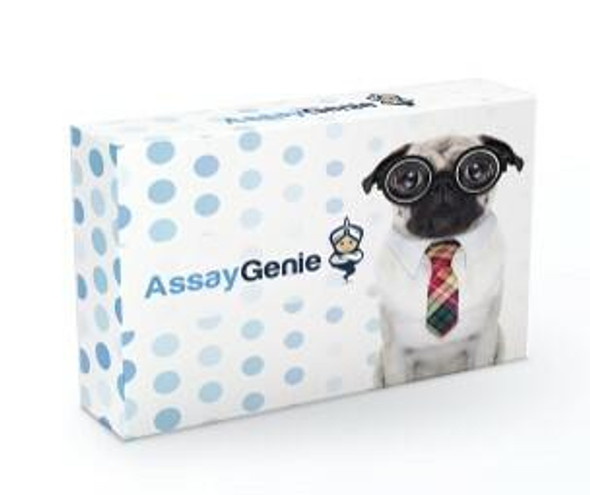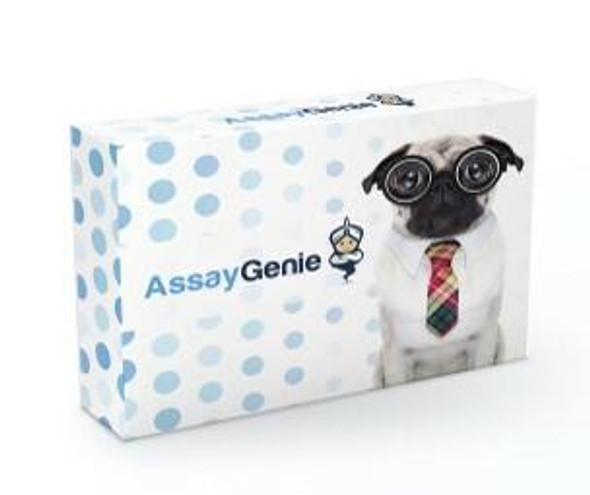Description
Human ProPPY/PI PharmaGenie ELISA Kit
| Product SKU: | SBRS0107 |
| Size: | 96T |
| Application: | This ELISA kit is designed to detect human, mouse, and rat pro-pancreatic polypeptide (Pro-PPY) and pancreatic icosapeptide, not active pancreatic polypeptide. |
| Uniprot: | P01298 |
| Gene ID: | 5539 |
| Gene Names: | PNP / PPY |
| Synonyms: | Pancreatic prohormone (Pancreatic polypeptide) (PP) (Obinepitide) [Cleaved into: Pancreatic hormone (PH) Pancreatic icosapeptide (PI)] |
| Target Species: | Human, Mouse, Rat |
| Compatible Sample Types: | Cell Culture Supernatants, Serum |
| Design Principle: | Competition-based |
| Method of Detection: | Colorimetric |
| Quantitative/Semi-Quantitative: | Quantitative |
| Range: | 0.1-1,000 ng/ml |
| Sensitivity: | 0.5 ng/ml |
| Recommended Dilution: | Human: 2X, Mouse: 2X, Rat: 2X |
| Storage/Stability: | Standard, biotinylated peptide, and positive control should be stored at -20°C after arrival. Avoid multiple freeze-thaws. The remaining kit components may be stored at 4°C. Opened Microplate Wells and antibody (Item N) may be stored for up to 1 month at 2 to 8°C. Return unused wells to the pouch containing desiccant pack and reseal along entire edge. |
- Pre-Coated 96-well Strip Microplate
- Wash Buffer
- Standard Peptide
- Assay Diluent(s)
- Biotinylated Peptide
- HRP-Streptavidin
- TMB One-Step Substrate
- Stop Solution
- Assay Diagram
- Positive Control Sample
- Capture Antibody
- Technical Manual
Other materials and equipment required:
The Assay Genie Human ProPPY/PI PharmaGenie ELISA Kit (SBRS0107) will require other equipment and materials to carry out the assay. Please see list below for further details.
- Distilled or deionized water
- Precision pipettes to deliver 2 ul to 1 ml volumes
- Adjustable 1-25 ml pipettes for reagent preparation
- 100 ml and 1 liter graduated cylinders
- Tubes to prepare standard and sample dilutions
- Orbital shaker
- Aluminum foil
- Saran Wrap
- Absorbent paper
- Microplate reader capable of measuring absorbance at 450nm
- SigmaPlot software (or other software that can perform four-parameter logistic regression models)
- Prepare all reagents, samples and standards as instructed.
- Add 100 ul detection antibody to each well.
- Incubate 1.5 h at RT or O/N at 4°C.
- Add 100 ul standard or sample to each well.
- Incubate 2.5 h at RT.
- Add 100 ul prepared streptavidin solution.
- Incubate 45 min at RT.
- Add 100 ul TMB One-Step Substrate Reagent to each well.
- Incubate 30 min at RT.
- Add 50 ul Stop Solution to each well.
- Read plate at 450 nm immediately.
The PPY gene encodes a short protein precursor that is cleaved into Pancreatic polypeptide (PP), pancreatic icosapeptide (PI) and a 5- to 7- amino-acid oligopeptide. Pancreatic polypeptide (PP) is a polypeptide secreted by PP cells in the endocrine pancreas predominantly in the head of the pancreas. It consists of 36 amino acids and has molecular weight about 4200 Da. Pancreatic icosapeptide consists of 20 amino acids. Its secretion in humans is increased after a protein meal, fasting, exercise, and acute hypoglycemia and is decreased by somatostatin and intravenous glucose. Plasma PP has been shown to be reduced in conditions associated with increased food intake and elevated in anorexia nervosa. In addition, peripheral administration of PP has been shown to decrease food intake in rodents. PP is secreted by PP pancreatic cells of Langerhans islets. It stimulates the gastric juice secretion, but inhibits the gastric secretion induced by pentagastrine. It is the antagonist of cholecystokinin and inhibits the pancreatic secretion which was stimulated by cholecystokinin. After the meal, PP seric concentration rises up from 8 to 10 times more; glucose and fats also induce PP's level increase, but on parenteral introduction of those substances, the level of hormones doesn't change. The administration of atropine, the vagotomy, blocks the PP's after-meal secretion. The excitation of the vagus nerve, the administration of gastrin, secretin or cholecystokinin induce PP secretion. The augmentation of PP secretion was observed in hormonal-active pancreatic tumors (insulin, glucagon), in Verner-Morrison syndrome, and in gastrinomas. The function of PI is unknown. The presence of porcine PI in sera is a marker of graft survival of fetal porcine pancreatic tissue in diabetic immunocompetent mice in the first 2 weeks after transplantation. This ELISA kit is designed to detect pro-pancreatic polypeptide (Pro-PPY) and pancreatic icosapeptide.





